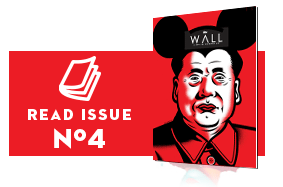Do you know “Pigment Workroom”?
We had the pleasure to speak with one of the creators of this initiative. That’s how defined themselves.
Pigment Workroom is a multidisciplinary start-up based in Bari (Southern Italy, Puglia, “the heel of the boot”), working as a laboratory for participatory urban art projects and handcrafted printing. We aim to work with artists, illustrators and creators that we find talented and innovative, both in their style and contents. On the other hand, we want to map needy and abandoned urban spaces –suburban walls, buildings, streets or entire neighborhoods– and provide them with a new aesthetic dimension, through a participatory street art model, involving artists and residents.
Pigment has started on June 2014 with a Bari-based project called “Enziteto Real Estate – A colorful escape to the suburbs”. Five Italian street artists have been involved: Alberonero, Alfano, Ciredz, Geometric Bang and Tellas. The project was located in the social housing neighborhood of San Pio, formerly known as Enziteto (this name is still used by its residents). San Pio was built during the 50s as an isolated neighborhood, located outside the Bari urban area. During the decades, this ghetto-status has dramatically affected the social and cultural context of the neighborhood. Today San Pio counts more than 3,000 residents and it is renowned as one of the most dangerous spots in town, with a high rate of organized crime, mostly concerning drug dealing and racket. The only active shops in the area are a coffee shop and a bakery. A remarkable amount of male adults are serving time in jail or on house arrest, so the neighborhood appears as a matriarchy, with a huge number of women and children.
“Estate” is a word that exists both in Italian and English. Read in Italian [/es’tate/], it designates summer. In English, “estate” can have more than one meaning. It is employed for properties on sale –and “real estate” usually designates a kind of prestigious property– or it can be a synonym of heritage, legacy and patrimony. It is therefore something inferring an upper-class context.
Not without a hint of sarcasm, the title “Enziteto Real Estate” aims to challenge the cliché according to which social housing neighborhoods are urban areas of no cultural interest: a dangerous and self-inflating commonplace, hard to be defeated in collective imagination. This entails a series of questions of aesthetical, ethical, sociological and architectural relevance, for instance: why social housing buildings and urban areas have to be flat and colorless, or even “ugly”? The equation beautiful = high-priced is deep-rooted in Western conception of producing human necessities. This keeps on generating serious inequalities, affecting social relationships and lifestyle.
San Pio’s residents, from children to the eldest, accepted our initiative with the warmest welcome. Everyday some of them supplied the artists with cold water or beer, coffee and “focaccia” (a local version of pizza). Mothers let children hang out with the artists and help them finishing the walls. The artists worked about 14 hours a day and realized four huge walls and further small interventions around the neighborhood. The cooperation, the social and cultural blending that resulted from this initiative represent without any doubt the most successful achievement of Enziteto Real Estate.

WALL #1: “San Pio is watching you”, Alfano + Geometric Bang

WALL #2: “By Stefano, 36 tones”, by Alberonero

WALL #3: “La grandezza del mare immenso”, Tellas

WALL #4: “Overview”, by Ciredz

